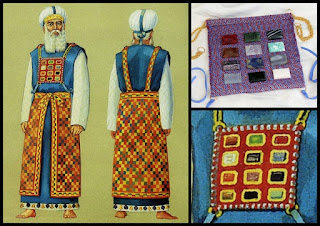THE LIVES OF THE PATRIARCHS #172 | THE LIFE OF MOSES #153
Pastor Christopher Choo,
Lesson 3858
THE LIVES OF THE PATRIARCHS #172
THE LIFE OF MOSES #153
MOSES AT MT.SINAI #52
THE TABERNACLE OF MOSES ( Part 11 )
THE EPHOD ( BREASTPLATE ) OF THE HIGH PRIEST #1
The priestly breastplate (Hebrew: חֹשֶׁן ẖošen) was a sacred breastplate worn by the High Priest of the Israelites, according to the Book of Exodus.
In the biblical account, the breastplate has sometimes termed the breastplate of judgment, because the Urim and Thummim were placed within it. These stones were, at times, used to determine God's will in a particular situation (see Exodus 28:30).
In the Old Testament, the ephod has two meanings.
1. Ephod as a Special Garment
In one group of passages, it signifies a garment; in another, very probably an image.
As a garment, the ephod is referred to in the priestly ordinances as a part of the official dress of the high priest. It was to be made of threads “of blue and of purple, of scarlet, and fine twined linen” and embroidered in gold thread “with cunning work” (Exodus 28:4; 29:5; 39:2; Leviticus 8:7).
The ephod was held together by a girdle of similar workmanship sewed on to it. It had two shoulder pieces, which, as the name implies, crossed the shoulders, and were apparently fastened or sewed to the ephod in front. In dressing, the shoulder pieces were joined in the back to the two ends of the ephod. Nothing is said of the length of the garment. At the point where the shoulder pieces were joined together in the front “above the girdle,” two golden rings were sewed on, to which the breastplate was attached.
2. Ephod as an Idolatrous Image
The word Ephod has an entirely different meaning in the second group of passages, all of which belong to the history books.
It is certain that the word cannot here refer to a garment.
This is evident in Judges 8:26–27, where it is recorded that Gideon took from the Ishmaelites, who were Midianite allies, golden earrings, weighing 1,700 shekels of gold, and made an “ephod thereof, and put it in his city, even in Ophrah,” where it was worshiped by all Israel.
In Judges 17:5, Micah made an ephod and teraphim, or idol, for his sanctuary.
The most natural inference from all these passages is that “Ephod” here signifies an image that was set up in the sanctuary, especially since the word is cited with teraphim, which undoubtedly refers to graven images (Hosea 3:4).
The conclusion is that Ephod, in these cases, refers to a portable idol. Some scholars have suggested that the connection between the idol and the garment is that the idol was originally clothed in a linen garment, and the term Ephod gradually came to describe the idol as a whole.
Conclusion
There are deep meanings attached to the Ephod as an essential garment of the High Priest.
It is actually a breastplate of remembrance ( of the 12 tribes of Israel signified by choice stones arranged in 4 groups of threes in a row) that the High Priest brings before God in his priestly duties.
From this, we can see that the people of God are close to the heart of the High Priest especially when Jesus becomes the High Priest who in His resurrection becomes our intercessor.
This beautiful breastplate which glows within the Holy Place reminds us that we are but reflectors of the Shekinah Glory of God.
Recall the two disciples on the road to Emmaus?
Their hearts were ignited within when the resurrected Christ walked with them and shared the revelation that He is the Word incarnate as prophesied by the Law and the Prophets.
In Luke 24 all three of them were walking to Emmaus from Jerusalem on the day of His Resurrection. The disciples later described their experience with the risen Christ as “our hearts burning within us while He talked with us” (verse 32)
Such is the power of Christ's presence with and within us to turn us into
" living stones " through the ministry of His Word.
May these lessons on the Ephod of the High Priest which is also called the Breastplate teach us more about who we truly are in Christ.




